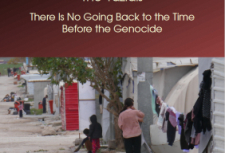Yezidis of Europen - in search of stability and well-being

History has repeatedly shown us that the Yazidis were forced to migrate to different countries, such as Georgia, Russia and Armenia. At the end of 90s and beginning of 2000s a part of the Yazidis has begun a new phase of migration. Because of economic problems, they decided to find a stable life for themselves and their loved ones. Only from 1990 to 2000 disintegration factors forced more than 100 thousand Yazidis to leave Armenia and Georgia. Many of them, having left their favorite Tbilisi and mountainous regions of Armenia, firstly (more than 95 % of refugees), as Russian-speaking people immigrated to the Russian Federation. Only a few of them went to neighbor Ukraine and Western Europe. At that time, it was possible to find stability and well-being in Europe, but of course it was difficult to get the desired. Long bureaucratic procedures took both - money and effort. Many of them achieved their goal and got to European countries such as France, Germany, Belgium, etc. A radical change of situation frightened Yazidis. They didn’t know language, a different mentality, a different culture, all these factors predetermined the future of the Yazidis of Europe. They began to join together, to hold each other, they created a community, organization, joint meeting of the holidays and all these helped them very much. There should be noted that they become more interested in religion and their culture and try to adhere to it.
The first appearance of Yazidis in France. In the early 1990s, the number of Yazidis living in France was small. These were mainly Yazidis-refugees from Turkey and several families from Iraq and Syria. Immigration of "Soviet" Yazidis began in 1992, and at the end of the 1990s took a mass character. They were spread throughout France without a predetermined plan or principle of ethnicity.
According to Tamaz Dasani, President of the Federation of Yazidis of France (the FYF): " Yazidis Diaspora were formed in three directions: 1) the Yazidis of Turkey, Iraq and Syria; 2) the Yazidis from the former Soviet Union; 3) the Yazidis, which, for some reasons, deported from Germany, Belgium and Holland. Until the mid-1990s, the Diaspora of the Yazidis of France was small, perhaps about 1 thousand people. These were mostly refugees from Turkey and a bit of Iraq and Syria who live in and around Mosel. The number of Yazidis from Iraq increased significantly (by about 200 families) after the 2014 Shangal genocide, which arrived in France under a special asylum procedure.
According to Vitaly Nabiev – Deputy President of the Union of Yazidis of France (UYF). The Diaspora of the Yazidis of France is more than 12 thousand people, from which more than 90% come from the former Soviet Union. The Diaspora was formed gradually for nearly 18 years and currently represents though divided, but the traditional community. They try to preserve their culture. There are also public organizations that take part in the social and political life of France. In recent years, the influx of Yazidi immigrants from the former Soviet Union has decreased markedly, and from Syria and Iraq, on the contrary, increased.
Also is needed to pay attention to the Yazidis, which live in Germany. This year in the German city of Oldenburg, was held a forum in honor of the 25th anniversary of the "house of Yazidis of Oldenburg". The Director of this center is Shaab Dagi and co-head Telim Tolani. This organization pursues the same goals as the FEF and the SEF. In Germany, the Yazidis first appeared about 50 years ago and also at first were scattered, but then began to unite.
Besides the public organizations, Yazidis in Europe are trying to manifest and show themselves in almost all spheres of social life, whether it is sport or some talk show.
After the genocide in 2014, the world society decided to address the problems of Yazidis in the middle East.
They began to help the Yazidis to emphasize their identity. Girls who were able to escape from captivity, began to talk about the troubles. European States began to help them, in particular France and Germany. In 2018, the Nobel peace prize was awarded to Nadia Murad, which is Yazidi. Thanks to her activity, the world has learned about the atrocities which are committed till nowadays. With the help of European lobbies Nadia has created charity fund “Nadia’s initiative” (https://nadiasinitiative.org/). The initiative advocates for victims of sexual violence and works to rebuild communities in crisis.
Thanks to the perseverance and strength of the Yazidis, wherever they are, they will always be active members of society and at the same time they do not forget about their roots, traditions and religion, because all these features make us Yazidis.
yazidis.info
Tags:
Yezidis of Europen - in search of stability and well-being

History has repeatedly shown us that the Yazidis were forced to migrate to different countries, such as Georgia, Russia and Armenia. At the end of 90s and beginning of 2000s a part of the Yazidis has begun a new phase of migration. Because of economic problems, they decided to find a stable life for themselves and their loved ones. Only from 1990 to 2000 disintegration factors forced more than 100 thousand Yazidis to leave Armenia and Georgia. Many of them, having left their favorite Tbilisi and mountainous regions of Armenia, firstly (more than 95 % of refugees), as Russian-speaking people immigrated to the Russian Federation. Only a few of them went to neighbor Ukraine and Western Europe. At that time, it was possible to find stability and well-being in Europe, but of course it was difficult to get the desired. Long bureaucratic procedures took both - money and effort. Many of them achieved their goal and got to European countries such as France, Germany, Belgium, etc. A radical change of situation frightened Yazidis. They didn’t know language, a different mentality, a different culture, all these factors predetermined the future of the Yazidis of Europe. They began to join together, to hold each other, they created a community, organization, joint meeting of the holidays and all these helped them very much. There should be noted that they become more interested in religion and their culture and try to adhere to it.
The first appearance of Yazidis in France. In the early 1990s, the number of Yazidis living in France was small. These were mainly Yazidis-refugees from Turkey and several families from Iraq and Syria. Immigration of "Soviet" Yazidis began in 1992, and at the end of the 1990s took a mass character. They were spread throughout France without a predetermined plan or principle of ethnicity.
According to Tamaz Dasani, President of the Federation of Yazidis of France (the FYF): " Yazidis Diaspora were formed in three directions: 1) the Yazidis of Turkey, Iraq and Syria; 2) the Yazidis from the former Soviet Union; 3) the Yazidis, which, for some reasons, deported from Germany, Belgium and Holland. Until the mid-1990s, the Diaspora of the Yazidis of France was small, perhaps about 1 thousand people. These were mostly refugees from Turkey and a bit of Iraq and Syria who live in and around Mosel. The number of Yazidis from Iraq increased significantly (by about 200 families) after the 2014 Shangal genocide, which arrived in France under a special asylum procedure.
According to Vitaly Nabiev – Deputy President of the Union of Yazidis of France (UYF). The Diaspora of the Yazidis of France is more than 12 thousand people, from which more than 90% come from the former Soviet Union. The Diaspora was formed gradually for nearly 18 years and currently represents though divided, but the traditional community. They try to preserve their culture. There are also public organizations that take part in the social and political life of France. In recent years, the influx of Yazidi immigrants from the former Soviet Union has decreased markedly, and from Syria and Iraq, on the contrary, increased.
Also is needed to pay attention to the Yazidis, which live in Germany. This year in the German city of Oldenburg, was held a forum in honor of the 25th anniversary of the "house of Yazidis of Oldenburg". The Director of this center is Shaab Dagi and co-head Telim Tolani. This organization pursues the same goals as the FEF and the SEF. In Germany, the Yazidis first appeared about 50 years ago and also at first were scattered, but then began to unite.
Besides the public organizations, Yazidis in Europe are trying to manifest and show themselves in almost all spheres of social life, whether it is sport or some talk show.
After the genocide in 2014, the world society decided to address the problems of Yazidis in the middle East.
They began to help the Yazidis to emphasize their identity. Girls who were able to escape from captivity, began to talk about the troubles. European States began to help them, in particular France and Germany. In 2018, the Nobel peace prize was awarded to Nadia Murad, which is Yazidi. Thanks to her activity, the world has learned about the atrocities which are committed till nowadays. With the help of European lobbies Nadia has created charity fund “Nadia’s initiative” (https://nadiasinitiative.org/). The initiative advocates for victims of sexual violence and works to rebuild communities in crisis.
Thanks to the perseverance and strength of the Yazidis, wherever they are, they will always be active members of society and at the same time they do not forget about their roots, traditions and religion, because all these features make us Yazidis.
yazidis.info
Tags:

























